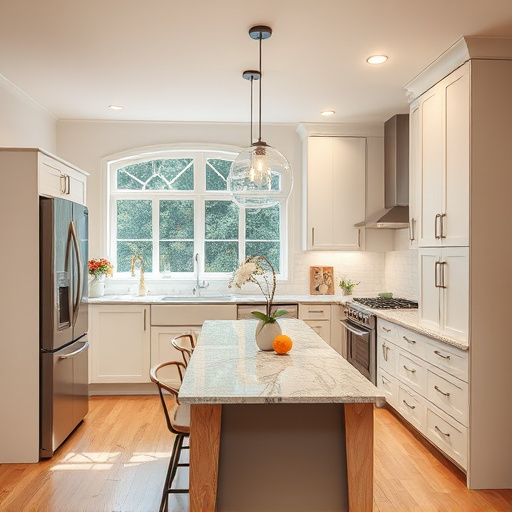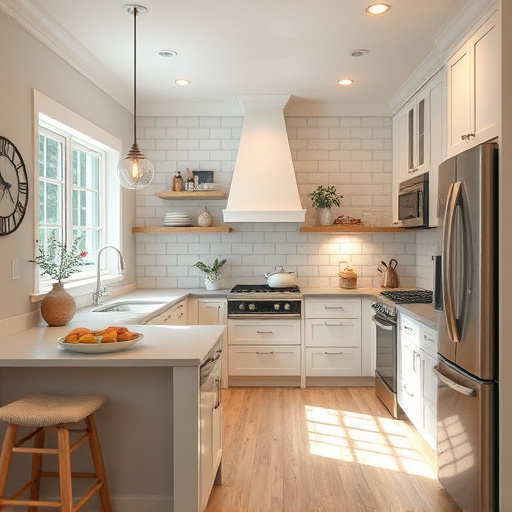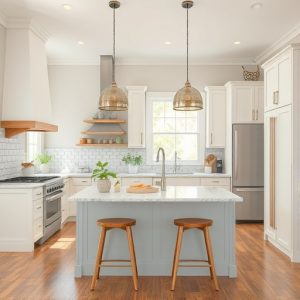Kitchen renovations focused on flow transform a functional space into a vibrant hub fostering togetherness. Prioritize storage solutions, workstation layout, and seamless movement to enhance aesthetics and speed up tasks. Evaluate current layout, create a scale drawing, and plan improvements based on daily activities and storage needs. Use professional help for precise floor plans and stay adaptable during renovation for successful kitchen renovations.
Redesigning your kitchen layout can transform your daily routine and cooking experience. In today’s fast-paced lives, a well-organized, functional kitchen is essential for efficient food preparation and enjoyment. This article guides you through the process of optimizing kitchen flow and functionality with practical tips on assessment, design, and implementation. From identifying issues in your current setup to designing storage solutions and improving traffic flow, we provide insights for successful kitchen renovations, ensuring a more pleasant and productive culinary space.
- Understanding the Importance of Kitchen Flow
- Assessing Your Current Layout: Identifying Issues and Opportunities
- Designing for Functionality: Storage, Workstations, and Traffic Flow
- Implementing Changes: Tips for a Successful Kitchen Renovation
Understanding the Importance of Kitchen Flow

In the realm of kitchen renovations, understanding the importance of flow is paramount. A well-designed kitchen layout not only enhances aesthetics but also significantly improves functionality. The kitchen is often described as the heart of a home, and its layout should reflect this central role by facilitating seamless movement between different stations—from food preparation to cooking, serving, and cleaning up. Efficient flow ensures that tasks are completed faster and with less stress, making the space more enjoyable and comfortable for all users.
Optimizing kitchen flow involves thoughtful consideration of both physical spaces and workflow. For instance, keeping frequently used items within easy reach and arranging appliances in a logical sequence can reduce time wasted searching for tools or crossing through traffic areas. A seamless flow also promotes social interaction, allowing family members or guests to comfortably engage while meals are being prepared, fostering a sense of togetherness. Thus, when embarking on kitchen renovations, prioritizing good flow is key to creating a functional, vibrant, and bustling space that serves as the soul of your home.
Assessing Your Current Layout: Identifying Issues and Opportunities

When considering kitchen renovations, the first step is to critically assess your current layout. Take a close look at how you use your space and identify any issues or inefficiencies. For example, do you often bump into cabinets while navigating the room? Is there inadequate counter space for meal preparation? Or perhaps the flow between the kitchen and adjacent areas feels disconnected, making it difficult to entertain guests. By pinpointing these challenges, you can uncover opportunities for improvement.
Pay attention to traffic patterns, appliance placement, storage solutions, and even natural light availability. These factors play a significant role in determining a kitchen’s functionality. Measuring each area and creating a scale drawing can help visualise changes and test different configurations before embarking on any renovation project.
Designing for Functionality: Storage, Workstations, and Traffic Flow

When redesigning your kitchen layout for improved flow and functionality, prioritizing storage solutions is paramount. Efficient storage not only keeps your space organized but also ensures that essential tools and ingredients are easily accessible. Incorporate a mix of upper and lower cabinets, pull-out drawers, and under-counter spaces to maximize storage potential. Consider adding built-in organizers like spice racks or vegetable drawers to make the most of every inch.
Workstations play a crucial role in streamlining kitchen activities. Design your layout to create designated areas for various tasks—a prep station with ample counter space, a cooking zone equipped with a range and oven, and a cleanup area with a sink. Ensure these workstations are strategically placed to facilitate seamless movement between them. Efficient traffic flow is key, allowing you to move from one task to another without unnecessary obstacles or clutter. Kitchen renovations that focus on these functional elements can significantly enhance your culinary experience and make everyday tasks more manageable.
Implementing Changes: Tips for a Successful Kitchen Renovation

When redesigning your kitchen layout, it’s crucial to approach the project with a clear vision and practical strategies for implementation. Start by assessing your current space, identifying pain points, and prioritizing improvements based on daily routines and storage needs. Consult with professionals or utilize online tools to create detailed floor plans that accommodate your desired workflow.
During the renovation process, stay true to your design goals while remaining open to adjustments. Quality materials and hardware can significantly enhance both aesthetics and functionality. Regularly communicate with contractors and designers to ensure timely completion and budget adherence. Remember, successful kitchen renovations involve careful planning, expert guidance, and a willingness to adapt for a space that truly serves and inspires.
Redesigning your kitchen layout is not just about aesthetics; it’s a strategic move towards enhancing daily routines and overall satisfaction. By understanding the importance of flow, assessing your current space, prioritizing functionality, and implementing thoughtful changes, you can transform your kitchen into a vibrant hub that facilitates cooking, socializing, and family bonding. Embracing these principles ensures a seamless kitchen renovation process, making everyday experiences in this essential space more enjoyable and efficient.
